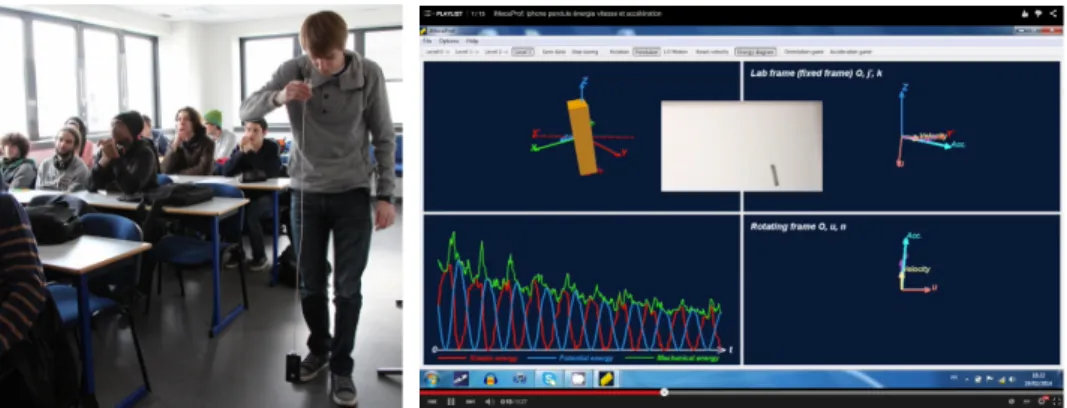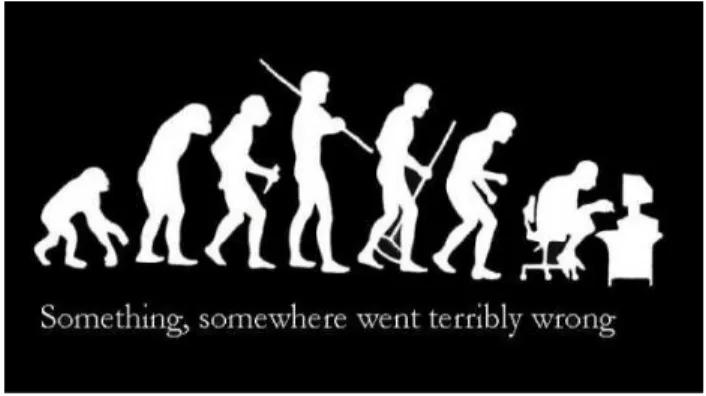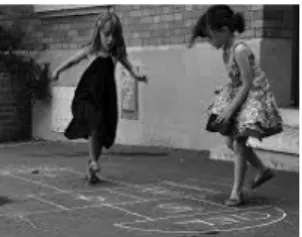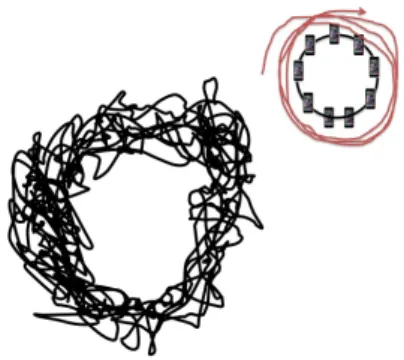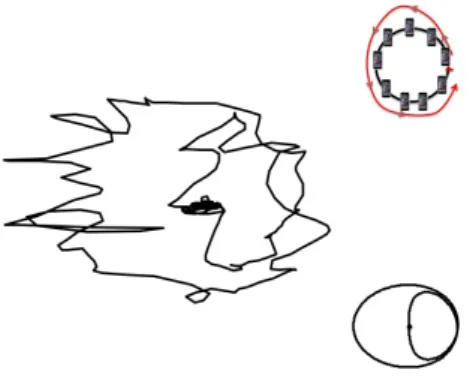HAL Id: hal-01180294
https://hal.archives-ouvertes.fr/hal-01180294
Submitted on 24 Jul 2015
HAL is a multi-disciplinary open access
archive for the deposit and dissemination of
sci-entific research documents, whether they are
pub-lished or not. The documents may come from
teaching and research institutions in France or
L’archive ouverte pluridisciplinaire HAL, est
destinée au dépôt et à la diffusion de documents
scientifiques de niveau recherche, publiés ou non,
émanant des établissements d’enseignement et de
recherche français ou étrangers, des laboratoires
Joel Chevrier, Laya Madani, Ahmad Bsiesy
To cite this version:
Joel Chevrier, Laya Madani, Ahmad Bsiesy. Can a smartphone be a HomeLab ?. LearnxDesign
Chicago 2015, Jun 2015, Chicago, United States. �hal-01180294�
Copyright © 2015. Copyright of each paper in this conference proceedings is the property of the author(s). Permission is granted to reproduce copies of these works for purposes relevant to the above conference, provided
Can a smartphone be a HomeLab ?
Joël CHEVRIER*, Laya MADANI
and Ahmad BSIESY
CIME Nanotech, Université Grenoble Alpes, F-‐38000 Grenoble, France *Corresponding author e-‐mail: joel.chevrier@ujf-‐grenoble.fr
Abstract: There are 2 billions of smartphones on earth. Each has more than 10
sensors, which collect data to localize the smartphone in space and time, to follow its displacement and to analyse gestures and movements. Through a real-‐time scientific treatment, the smartphone human interface makes available to
everybody this monitoring of the world around us. This interface based on a global approach of the connected man is due to design. Interfaces based on new
collaborations between sciences and design, have been developed for smartphone health applications. In field of education, we have entered building a new
smartphone human interface dedicated to investigation of gesture and movement at K-‐12 level. This new program follows the one based on a software iMecaProf now used to teach physics at university. In real-‐time and interactively, it analyses localisation and displacement and represents results on a PC screen within science formalism. For associated students in design, innovation and challenge is: “what real-‐time and interactive representation of smartphone data, so that K-‐12 students can discover gesture and movement using gyro and accelerometer data?” Accelerometer records a trace associated to trajectory but also to the dynamic of displacement, closely related to rhythm in music and dance.
Keywords: mobile devices, science education, sciences and design, graphic
Introduction
Design, Science and Technology are more and more a playground for ‘The making of contemporary worlds’ (Goodman, 1978). One of the major productions, which is a result of this synergy, is the smartphone. Smartphones are nowadays 2 billions on earth and they clearly changed the daily life of people whatever their country, their age, their culture and way of life. Our research program is here dedicated to studying how smartphones can be turned into educative tools to explore the world around us (Vogt, 1972). This is done with science and design students working together.
Scientists of our groups have first produced a user interface named iMecaProf (Chevrier, 2013) without the help of designers. It is now used to teach physics at university. In this case, the smartphone becomes a scientific instrument, which transfers, in real-‐time, its sensor data to this user interface run on a PC. The pedagogical key advantage is the real-‐ time and interactive use of the scientific formalism as a tool to analyse collected data. This highly specialized user interface is based on advanced mathematical descriptions of concepts such as space, time, trajectory and displacement. It essentially casts the collected data into a well-‐established formalism universally shared by scientists. In this case, scientists alone have been able to produce this user interface for freshmen at university studying Basic Mechanics. The breakthrough is noticeable. For the first time ever, students can have their own advanced physics lab at home as long as they are equipped with a smartphone and a PC to treat and represent data.
Figure 1 a) the smartphone and its charge cable are now a pendulum. A student controls it by hand and b) can quantitatively follow the situation on a screen in real time using the formal description of this movement (acceleration and velocity vectors, energy versus time).
It is possible to scientifically study these concepts using smartphones as instruments for an excellent reason: necessary sensors monitoring space, time, trajectory, displacement are at work in smartphones with high-‐level performances. The reason why they are embedded in smartphones is that they are needed to insert smartphones in our daily life. We live and move in a Euclidean space and smartphones probe this with their sensors. Designers have produced a smartphone user interface that completely hides real-‐time data collection and the associated scientific treatment, in fact all what we make apparent for science teaching.
An impressive result is that the smartphone interactive user interface is used by anybody with essentially no prerequisite, no a priori knowledge. The basic idea is that these data after a scientific treatment are available for the human perception through tactile screened and loud speakers. This is clearly shown in Steve Jobs keynote (Jobs, 2010). This is certainly a central aspect of the smartphone success, which has led to this explosive development during the last few years.
Experimental science versus smartphone
Design is the referee
We here define a framework starting with two extreme situations: i) when smartphone is turned back into a scientific instrument, the work of designers to produce the smartphone user interface is essentially erased and ii) in smartphone regular use, the scientific layer that treats sensor data and feed the user interface, is made invisible. In this last case, as the control of smartphone in space and time is anchored on our perception, there are no explicit references to trajectory, displacement, translation or orientation. No quantitative data are proposed to the user related to these concepts in daily use of a smartphone.
These two extreme situations are not the only possible ones. Depending on the objective, users can be exposed to concepts related to space and time such as trajectory, displacement, translation and rotation in different ways, which in fact outweighs the above framework only based on two extreme regimes, and which rely on specific combination of essentially a scientific presentation of data and their direct perception. This alliance between science and design to produce various user interfaces, which often include user exposition to numbers issued from sensor measurements, appears to be clear at least in two different areas: sport and health. In sport, smartphones can be used to track performances and gesture quality (tennis, golf…). In health applications, information is provided either about heart beat, walked distance and used energy (see calorie counter). For example in Withings applications (Withings, 2009) or in some others equivalent products, key monitored health parameters are represented on screen using a combination between design and science. The point appears to be here that quantitative, relevant and reliable information is hence shown and immediately identified as such by the user. Reliability seems to be achieved when user interface includes a “scientific” appearance though it remains comfortable and accessible to all users. In the two cases mentioned above, it is noticeable that if data are represented on device screen, they can be collected during the whole body movement using external sensors (i.e. not only sensors embedded in smartphones).
All these applications can combine sensors (the technological aspect), a numerical treatment of collected data within a theoretical frame (the scientific ground), a data representation on smartphone through a user interface and dedicated devices, which include sensors and wireless connection to smartphones. Data collection, their treatment and representation are then put in separated devices. This organization of the hardware is of course associated to the separation between movement capture and its real time interactive representation on a screen. To us, this is where the collaboration between design and science is going to produce emerging ways of associating gesture and meaning.
Indeed in our program, the use of these devices together with smartphones can be a real breakthrough. They add even more possibilities of organization and collaboration between science and design in order to explore movements of hand, arm and body, and to transform them in a new channel for people interactions. Further user interface, which proposes a real-‐time and interactive representation of collected data, can in fact remotely and specifically activate channels of perception (sight, hearing and touch) and action (movement, gesture).
Exploration of the real with smartphone: why?
We can now turn toward what is our main goal after having built a user interface for students at university: how can we build new digital tools so that non scientists and/or K-‐12 children can explore and discover concepts related to space and time such as trajectory, displacement, acceleration, velocity in connection with body action and gesture. A clear objective is then here to contribute to digital literacy. The commonly shared knowledge and mastery of these concepts have been deeply transformed by people interaction with digital tools in daily life. It remains that the new digital ways proposed especially to young children to approach these important concepts matter. Are they confined to interaction with screens only? Major concerns are often expressed especially about young children if exposition in a novel way to these concepts means what is shown in figure 2. A key point here is to consider how body and its movement can be necessarily involved in this exploration of real and associated to gaming and fun.
Figure 2 Are we led more and more to see and to experience the world essentially through a screen with increasing development of digital tools?
Our research together with students in design is now focused on these points: • How can we involve not only attention focused on a screen but the whole body. • With new possibilities in digital world to represent displacements and gestures, can we
propose new tools that help development of children?
Figure 3 illustrates this demarche.
s
Figure 3 when digital tools enter children life: how can they add to life in real world? Source of bottom image: G. Lavalette https://www.flickr.com/photos/gerard_lavalette/3710117430/
Scientific education and design
Everything here starts with sensors and especially the 3D accelerometer that is present in every smartphone. 3D accelerometer does not give direct information on position in space. It does measure in all three directions how the speed is changing during a 3D displacement. If position is the objective, it has to be calculated at each point using the acceleration values measured from the very beginning of displacement. Technically determination of smartphone position in space requires double time integration of acceleration data. This procedure is often considered when using accelerometers. Although technically delicate when done in real-‐time, it could be a part of the hidden data treatment performed before use of information in user interface. This is not the only way to enable people to explore the real. The technical difficulty is not the first reason why we want to consider alternative approaches. Any formal treatment applied by the scientific analysis to collected data immediately implies key choices about explored concepts and theses choices then impose a rigid frame to users. This implicitly severely constrains any subsequently proposed representation. In others words, this classical treatment leads to conventional presentations of displacement: either an image of the trajectory with the complete loss of the movement dynamics or if in real time, a movie that shows to kids essentially their movements on screen as they directly perceive it. This is what is massively done in many games using screens and cameras. This somewhat conventional 2D presentation is very much a virtual mirror of our world, and it does not introduce the questioning we are looking for on space, time and associated concepts as it essentially tries to reproduce them on a screen in the best possible way. This objective and quantitative description can be impressive and very efficient, but it does not really challenge the scientific interrogation. Furthermore, on this basis, designers are bounded to insert their creativity and production into this realistic frame rigidly defined by scientists. Again this is not the way we want to enter the production of a representation of sensor data, supposed to become a playground for K-‐12 children in exploration of the aforementioned concepts.
In summary, if one applies a hidden scientific data treatment, the obtained description of movement in 3D space and time essentially determines its representation for our perception. One then loses many opportunities for original explorations through representation using audio-‐video media. To the contrary, playing with 3D acceleration measured by these sensors without any a priori treatment is simultaneously playing with a displacement and a trajectory but also with the dynamics of this movement or gesture, which is closely related to what rhythm is.
Figure 4 Three sticks moving and alternatively hitting cereals produce a rhythm in daily life. Source: Foli (there is no movement without rhythm), a movie by Thomas Roebers and Floris Leeuwenberg
Figure 4 is an image of the movie Foli or ‘There is no movement without rhythm’ (Roebers, 2010). The word for rhythm used by the Malinke tribes is ‘foli’. ‘There is no movement without rhythm’ is essentially what is in acceleration data. Image in figure 4 from this movie tries to illustrate this idea. Compared to this magnificent film, it is clearly a poor demonstration. This isolated image does not encompass the associated movement and rhythm, which is made evident by the conjunction of images and sounds in the movie.
Now together with students in design and in sciences, in order to enable people to play with movement and rhythm using sensors embedded in smartphones, we here face a challenging question. Acceleration data are products of micro-‐sensors in smartphones and can only have their full meaning if treated by scientists. Associated scientific concepts are often far removed from immediate everyday experience. This does not mean that they are disconnected from everyday experience. Their intensive use in smartphones for application in our daily life shows to the contrary how efficient they can be when it is to feed our perception. But the very much understandable choice made in mobile devices is to disconnect the inside scientific activity from their daily life use. In others words, it is not easy to analyze the smartphone user interface built on the numerical fusion and aggregation of all collected data in order to appreciate its proximity with the scientific description plugged on sensor data. Parallel to this, it is certainly equally difficult with this implemented smartphone user interface, to see how much smartphones can certainly be important tools to explore gestures and movements following the program at the heart of the movie ‘Foli’: ‘There is no movement without rhythm’.
Our horizon is now becoming very ambitious. Through sensor data, smartphones are efficient tools to explore the world around us. These data can only be treated within a set of scientific concepts which are at work in these machines and therefore in daily life. We want to give access to these concepts and to their associated description in science, but this is not to make them alien objects that can be used only by highly trained people and disconnected to other form of descriptions, knowledge and cultures. In future, we shall investigate how mobile devices, associated sensors and their connection to human perception through user interfaces based on screen, loudspeakers, etc. give us today the opportunity to explore and to enjoy, which is a key component of learning, the world around us, and in real and virtual contacts with others people.
Our hope is that it is possible, through an open process led by designers and scientists, to create a real-‐time and interactive representation that is original and innovative. It should be a playground related to all activities dealing with movement, displacement and gesture such as dance, music…
Real-‐time representation of acceleration data
Acceleration is the variation of the movement. It carries information about both trajectory and how this trajectory is followed. This is very close to the spirit of what is shown in movie Foli: music and dance start with ‘movement and rhythm’ in life. Many human movements, or gestures, are essentially periodic repetition in time and space: walking made of repeated steps, eating as repeatedly putting food in mouth, basic gestures in sports such as golf, tennis, but also swimming. Handwriting, at least when using latin alphabet, is based on only a few characteristic repeated drawings. On this basis, the present collaboration between design, computer science and physics tentatively explores innovative representations of movement and rhythm in our life, using sensor data collected by smartphones.
We are still in a preliminary approach as it is not a simple task to create such representations. As a minimum set up, it should enable the hand to manipulate the smartphone and the manipulator to observe simultaneously the result. Real-‐time results associated to real movement, can be drawings on screen, sounds through loud speakers. Screens and loud speakers are not those of the smartphone itself but of remote devices that feed the user perception with artifacts produced by its movement. These artifacts should carry the wealth of information found in acceleration about space and time, and, at the same time, be adapted to human perception. The obtained representation should be a serious game controlled by user movements. It should then be first entertaining and also stimulate the appetite for a real/virtual exploration of movements. Primarily based on action and perception, this sensitive exploration of acceleration should lead to discovery of and to acquaintance with concepts associated to movement such as trajectory, orientation, translation, velocity and acceleration in a 3D space.
A first attempt to approach this strategy has been done with implementation in our software iMecaProf of a real-‐time interactive experiment. There was no interaction with designer in this part of our work as described in introduction. The student has to simply reproduce an oscillation presented on the PC screen. Such an exercise would be of essentially no interest if one were supposed to reproduce a simple oscillating trajectory.
This would clearly generate no surprise or interrogation, would be no fun and one does not see clearly what could be learnt. There would then be no important added value in term of exploration. The aim of the proposed set up is that students can directly approach acceleration during oscillation through action and direct perception. We have therefore made the choice to plot on a screen linked to the smartphone with a wireless connection, the bare data produced by the accelerometer along the vertical axis as the smartphone is oscillated by hand. Students immediately understand that they have to oscillate the smartphone by hand vertically so that the curve produced follows the one defined by the computer. The question is in the details of oscillation so that the produced curved follows the model acceleration on screen. The oscillation frequency is randomly chosen between 0,5Hz and 3Hz, and the amplitude when at maximum displacement and reported on computer screen, is 1 g= 9,81m.sec-‐2. Used frequencies are easily followed by students except for the lowest as 0,5 Hz requires to be able to periodically move the smartphone one full oscillation every two seconds, which appears to be a very slow. This is made even more difficult as reproduction of the computer curve plotted on screen cannot be reproduced if only the frequency, in fact the rhythm, of the movement is controlled by the manipulating student. Real space amplitude of smartphone oscillation must be changed so that the acceleration curve displayed remains with a maximum at 1g. Many students have difficulties to decipher this and to change their actions accordingly: at high frequency, the smartphone in hand must oscillate at the required frequency but with a small amplitude movement. At 2Hz, the amplitude that must be used is 6 cm, whereas large amplitude movements must be done when required frequency is small. At 0,5Hz, which corresponds to a period of 2 seconds, the value of the amplitude that must be used is close to 1 meter. To obtain a 6 cm amplitude, it is enough to move one’s arm with smartphone in hand. Moving only one’s arm is clearly not enough to move up and down a smartphone with a total displacement of 2 meters. In that case, it is a surprise for students that slow body movements are needed and that they must slowly, very regularly and in rhythm, stoop by bending knees to reproduce a curve with constant amplitude on screen. In fact some key concepts we want to introduce when teaching oscillation, must be considered to analyze connection between what is on screen and the real displacement of arm and body. Sessions based on this exercise are organized with groups of students doing these manipulations by teams of two. The characteristic phases are: i) entering the manipulation by trial and error, ii) trying to rationalize observation and iii) finally, for these university students, learning a quantitative analysis using the taught formalism and putting numbers on all this. Technically, they have to relate their perception, or the way they adapt their movement, to this formula: Aω2 = 1 g where A is the amplitude that is half of the total displacement and which is related to frequency f through: ω=2πf. Understanding and mastering this formula is an important pedagogical objective for these students. Associated collective and lively discussions are part of the here used teaching method. In this first example, although not built together with designers, we observe at work simultaneously action, direct perception and scientific approach in the pedagogical process. Here students when they move smartphones to obtain the right oscillation, i.e. the right rhythm, are asked to behave first not as scientists but much more as musicians or dancers. Only after, are the students asked to analyze the situation in a scientific way so that they can produce better results when they try again.
Here the goal is reaching comprehension and intellectual mastering of scientific description of involved concepts. Students enter this phase only after they have faced the difficulty of producing the acceleration curve by hand. The final stage can be a feedback. After they have been exposed to the scientific theory of oscillatory behavior, students can come back to the serious game and see if this knowledge helps them to improve their performances.
In practice, implementation of this first attempt with students leads to very spectacular reactions among students: essentially surprise to see this use of smartphone and excitement, as they understand and have fun with the game. To us, theses reactions are also due to the introduction of a true experimental control in a real scientific experiment that is ensured in an unconventional way, i.e. by real time student perception. This is not only surprising but it can also be difficult to achieve such a control. First human qualities here required, are not purely intellectual. To the contrary there are the ones associated with production of the right movement using trial and error method and, at least at the beginning, much less those related to understanding the associated scientific background. With our serious game, in order to approach acceleration behavior of the smartphone, it is not necessary to behave in this first step as a scientist. When smartphone movement is controlled by hand, students start to spontaneously develop a strategy parallel to the one used in some sports or in dance, where the specific gesture is described, imagined and repeated before action. Key observed features and their connection with gestures are first discussed. In these discussions, as they progress to reach an advanced stage through the trial and error process, they are gradually led to use formal scientific description with help of teachers. Although very engaging and spectacular, we have only started with this lab experience and much more is needed to evaluate and better understand this promising method. Noticeably it is based on ‘go and return’ between action and perception, and scientific theory, which is then introduced through an interactive audio-‐visual representation and associated discussions. Comparison between theory and experiment as classically expected in science teaching is finally used here with students learning physics but only at very late stage of the process. This 1D oscillation here described is also an archetype of the periodic motion. This is closely related to music: the musician beats time. What we here propose to students is to ‘play science’ with smartphone in a way closely related to ‘playing music’ with an instrument.
An archetype of the 2D motion is the rotation or circular motion, either at constant speed (i.e. uniform motion) or not. Therefore no surprise: it is taught in details in Basic Mechanics courses all over the world. No surprise again: beyond observation of trajectory, nowadays done using video recording, it is not easy to access in real time through direct measurements, fundamental quantities such as speed or acceleration and to characterize them. A classical question is: ‘is this movement close to a uniform displacement or not (i.e. is it a rotation at constant speed)?’ A smartphone on a turntable or in a salad spinner gives immediate access to acceleration, speed and angle of rotation. Students have done this extensively, using the specific ‘level’ in our software iMecaProf that is dedicated to representation of rotations in real time. Smartphone performances are in fact well adapted to these experiments when the rotation angular speed is a few turns per minutes, as does a turntable or a salad spinner.
When using a turntable, smartphone is again considered first as a scientific instrument. In this particular case, there is no immediate connection with its design associated to its everyday use. Experimentally studying rotation using a smartphone clearly makes sense for students and is very close to what is classically done at university. These rotation speeds are also essentially the ones we can manually produce and follow with our eyes, i.e. the ones that are not too slow and not too fast, and that match human perception. This academic year, following what we have done in the serious game ‘1D oscillation’ described above, we have explored with students how man made circular movement can be scientifically studied and how key aspects can be explored and learnt when the smartphone is manipulated by hand. Immediate question as this approach is considered, is the quality of the movements using human ability to move the smartphone by hand. How far is it possible to go in the subsequent quantitative analysis of acceleration data produced this way? In order to stay the closest possible to observation of information present in these data, when perception is used, our present idea is to image in real-‐time the movement in a 3D acceleration space. This implements an original feedback loop for our action/perception scheme: when moving the smartphone by hand, one can simultaneously produce the real space trajectory and observe the acceleration curve on screen. To our knowledge, this has never been done and never considered so far. This is not a surprise: micro-‐accelerometers have been made widely available only a few years ago in smartphones.
Representation of acceleration curve on a screen as shown in figures 5 and 6, immediately challenges our perception of movement. Although the manipulator with smartphone in hand is at the origin of both the real trajectory and of its representation on screen, he has difficulties to identify the link between the trajectory in real space and what is presented on the screen. Basic mechanics emphasizes that what is observed on screen is related to both the smartphone trajectory in real space and to the way this path is traveled, i.e. the rhythm. All components of movement including the rhythm are represented on screen as a curve using acceleration data. We are now producing an application named Acceleration tracker, which will enable people to observe this curve on a screen as they manipulate their own smartphone. Figure 5 and figure 6 present examples of this.
Figure 5 As seen in corner, the smartphone travelled several turns with the best possible circles achieved by hand. Associated acceleration data approximately define a circle whose average radius in m.sec-‐2, is the one expected. One can now play with this using the real time and interactive representation Acceleration tracker.
In both cases, the hand, holding a smartphone, draws vertical circles with an approximate radius 0,3 meter. In figure 5, several circles are represented. Hand does not stop between circles and acceleration data are collected during several turns travelled at constant speed. ‘A circle is a circle’ is the result. The real trajectory is a circle and the curve in acceleration space is also a circle. This provides students with the appearance of a solid reference. But this straightforward correspondence between the two curves is certainly misleading, as it is a very peculiar case. In fact one of the reason why the uniform circular motion is heavily studied in physics courses, is the fact that circles are the right curves for the real space trajectory, the velocity and the acceleration. To be familiar with the associated theoretical description is a key pedagogical objective for freshmen in physics at universities. In strong contrast with usual practices in teaching labs, we now propose to physics students to explore the efficiency of this description starting with human movements recorded by smartphones. They can observe circles clearly not as perfect as the one produced by a turntable, by still clearly identified as a circle in smartphone data. They are quantitatively dealing with real data obtained during rotation of a smartphone by hand. An aspect that is also in contrast with regular scientific practices in physics, is the fact that
students become part of the experimental set up probed by the smartphone used here as an
instrument. We have not yet thoroughly analyzed the consequences of this change in the pedagogical sequence.
The real trajectory associated to the acceleration curve shown in figure 6 is still a circle. This circular trajectory is travelled by the smartphone starting at rest and stopping at the circle end. This means that the acceleration at both ends is zero. Compared to the acceleration curve obtained in figure 5, the curve is then completely changed as depicted by figure 6. This case illustrates the future of our work on this project: shall we be able to train ourselves so that it becomes possible to handle and to play with this representation? This is a key question here and our workshops in the near future with different publics should help us to propose an answer and to know if this approach can be used as an education tool.
Figure 6 As seen in upper right corner, the smartphone only travelled one turn with the best possible circle achieved by hand. Associated acceleration data are shown here (black curve). This is not a circle. Down right is the calculated curve for this particular case. With the real trajectory being a circle, the acceleration curve can be deeply transformed by the rhythm: sharp start and stop, high speed all along…
Concluding remarks
Smartphones enable students in physics to do meaningful experiments without any added materials. Direct manipulation connects the experimental objective procedure in acquisition of real data with direct perception of the movement, which appears as a clear added pedagogical value. This remains to be thoroughly investigated, but it certainly leads students to better appreciate the observed changes in acceleration curve. In any case, it shows once again how the smartphones can be transformed, in fact ‘hacked’, to become not only scientific instruments that they are at heart but a complete pedagogical environment when data are transformed and represented on separated devices in real-‐time to enable students to play with interactively. Following Steve Jobs who once said that the smartphone is perfect for gaming, we can add that it is perfect for DIY experimental science and for learning science. Graphic representation of bare acceleration data as collected by the manipulated smartphone does include both the path travelled by the smartphone and the way it has been travelled. This can be done in real time. Others data such as orientation angles from the gyroscope can be added if necessary. This is exactly the situation we were looking for to now enter the collaboration between scientists and designers. The aim of this collaboration is now to explore if new ways can be opened, which exhibit concepts associated to smartphone operation in space and time. The produced serious game based on a smartphone, on a representation implemented in separated devices (video and/or audio), of data acquired during smartphone manipulation should be created for non-‐ scientists of all ages.
References
Chevrier, J., Madani, L., Ledenmat, S., & Bsiesy, A. (2013). Teaching Classical Mechanics using Smartphones. The Physics Teacher 51(6), DOI: 10.1119/1.4818381
Goodman, N. (1978) Ways of Worldmaking. Indianapolis: Hackett. Jobs, S. (2010) CNET News Video: iPhone 4's new gyroscope
http://www.cnet.com/videos/iphone-‐4s-‐new-‐gyroscope/
Roebers, T. & Leeuwenberg, F. (2010) https://www.youtube.com/watch?v=lVPLIuBy9CY Vogt, P. & Kuhn, J. (2012). Analyzing free fall with a smartphone acceleration sensor. The
Physics Teacher, 50(3), DOI: 10.1119/1.3685123. Withings (2009) http://www.withings.com
